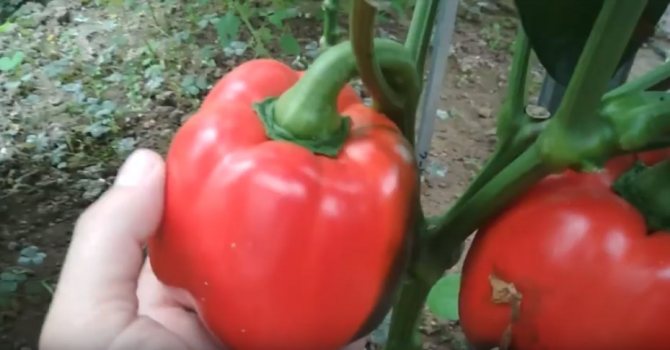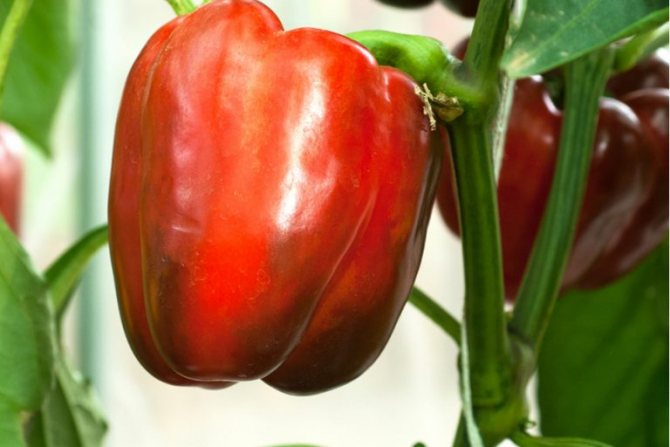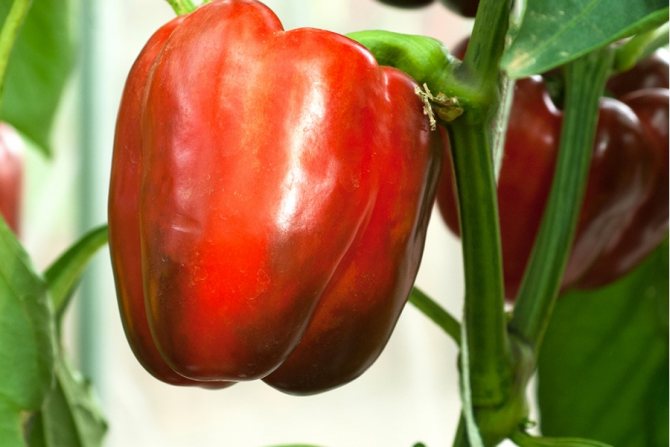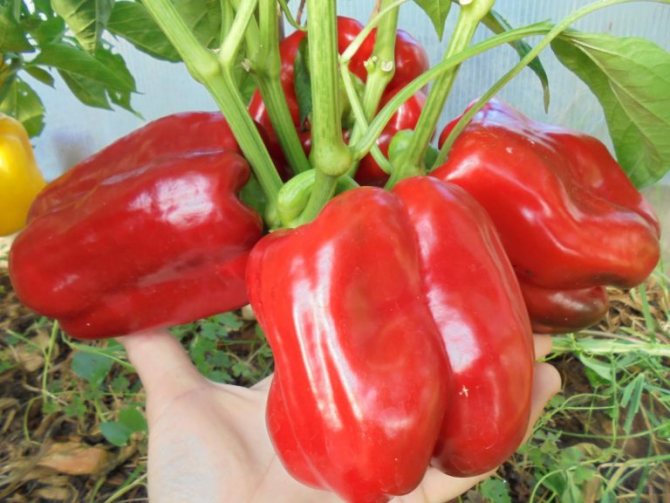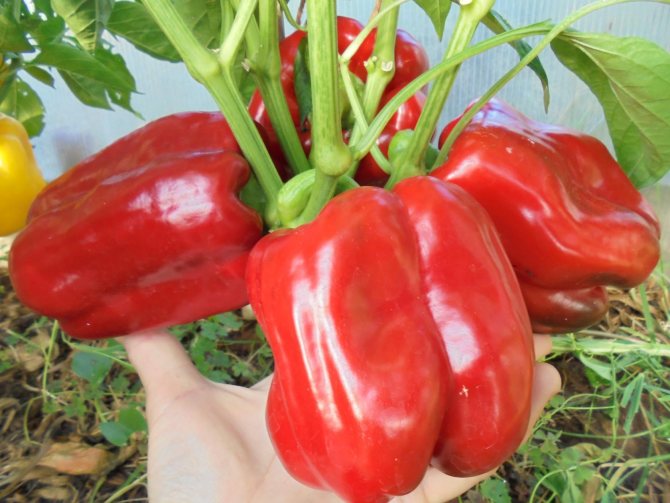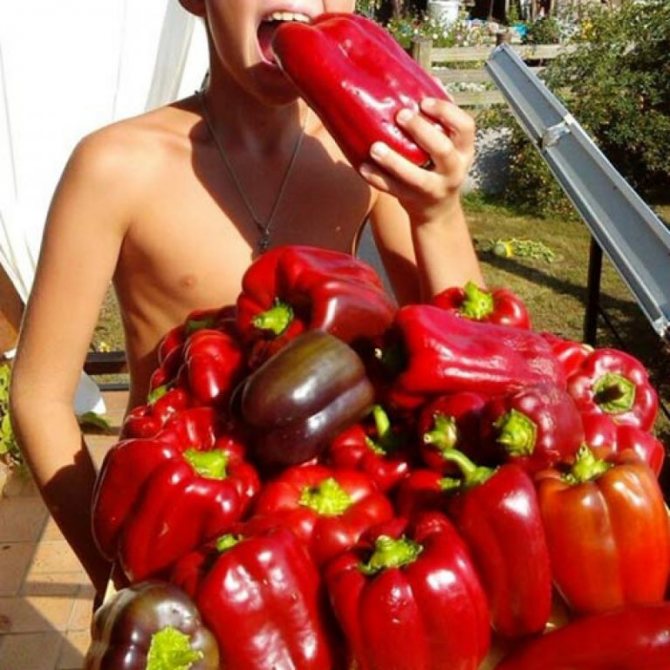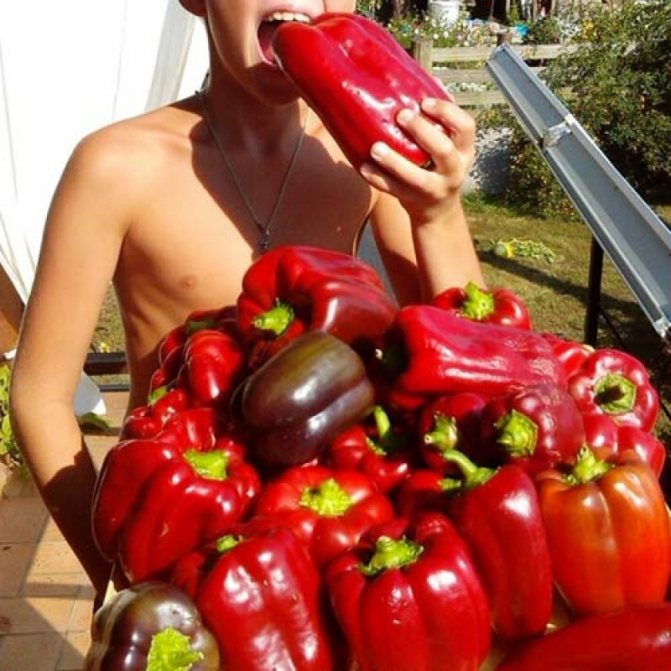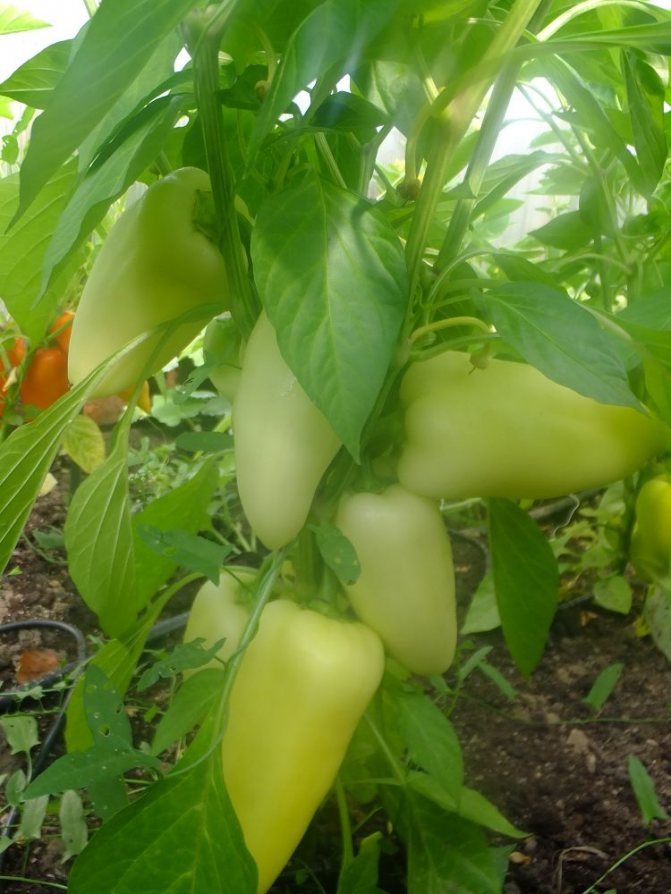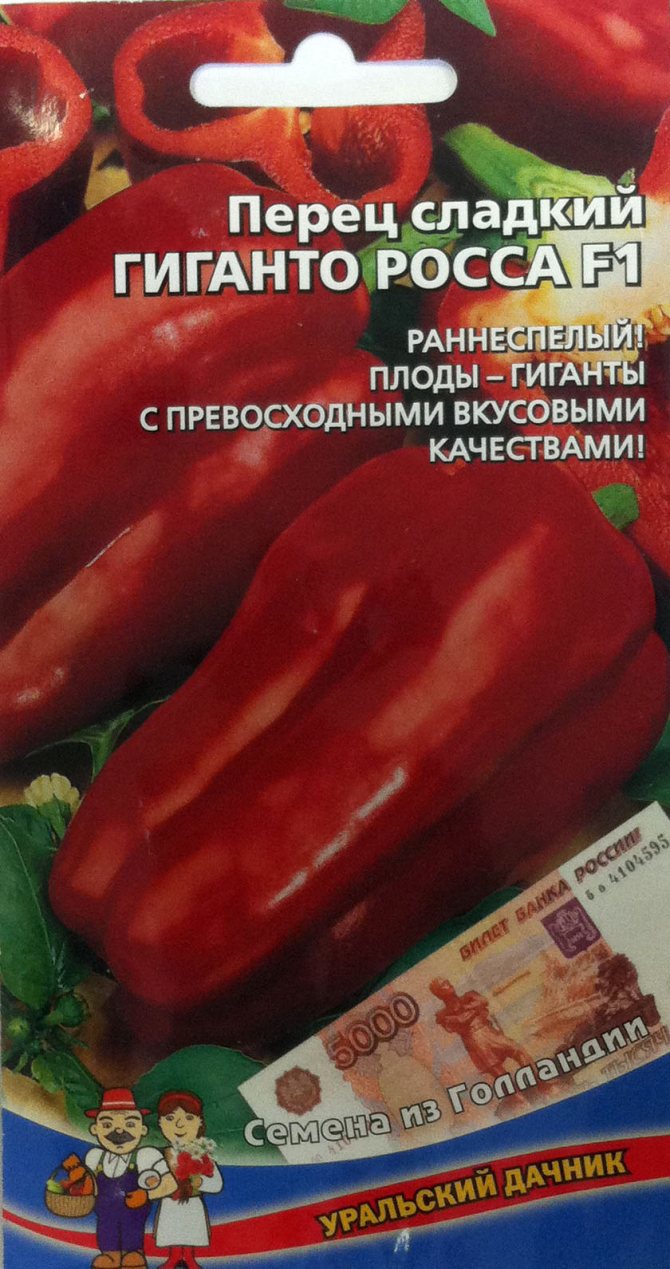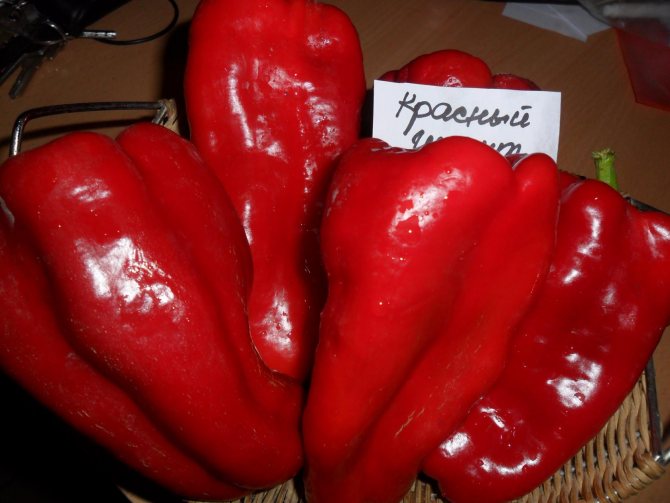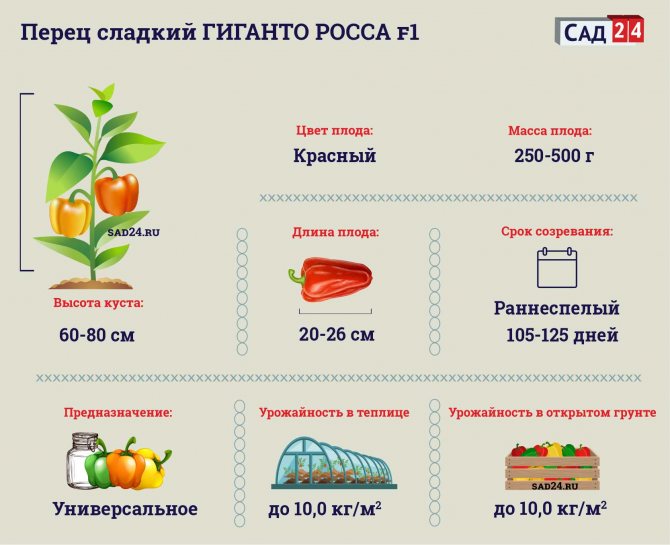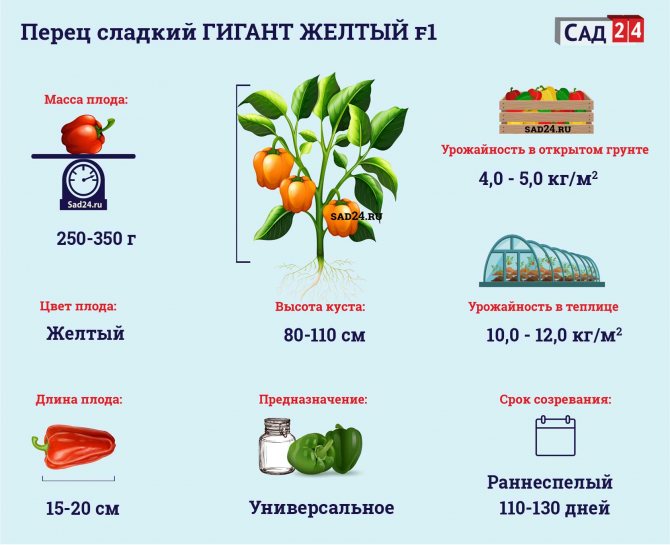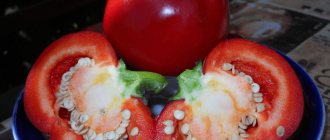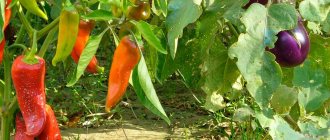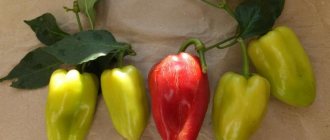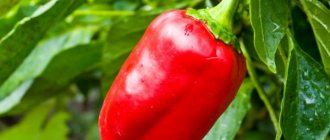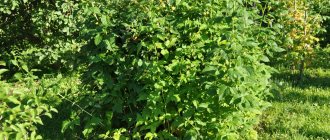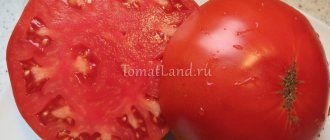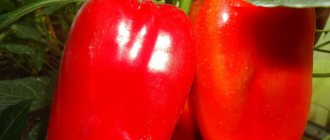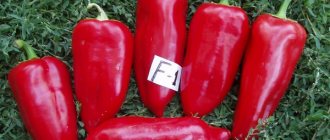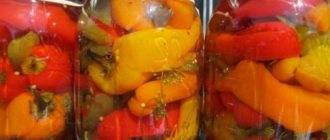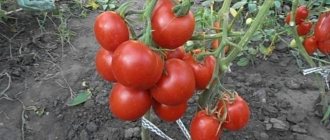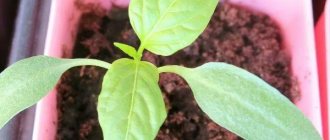Bell peppers are an indispensable ingredient in many dishes. This is not surprising: it is tasty, contains many useful nutrients and trace elements, and with its bright color it can revive any culinary masterpiece. Despite the availability of this vegetable for sale, our gardeners are trying to grow it in their gardens. One of the most popular varieties of pepper for growing in the beds is the Giant red f1. He fell in love with gardeners for high productivity, resistance to diseases and pests. According to the plant breeders' reviews, which are posted below, you will learn about the pros and cons of growing giant peppers.
Description of the variety
The plant is powerful, medium spreading bush, 80 to 120 cm high (orange - 60-70 cm).
Fruit characteristics:
- The weight of the peppers is from 150 to 300g.
- Cuboid shape.
- The color in the technical stage is light green, when ripe it takes on a bright red, yellow or orange (typical for this variety) color.
- The walls of the fruit are juicy, sweet, 8 to 12mm thick.
- The length of the peppers reaches 20cm.
- Universal use - for fresh consumption, preparation of various dishes, conservation, freezing.
Placing seedlings in the beds
Some conditions when placing young plants play an important role for the healthy growth and fruiting of the Giant, you should adhere to them if you dream of a rich harvest of this magnificent vegetable (see photo):
- To plant according to the scheme 45x75 cm, that is, the distance between the rows is 75 cm, and between the seedlings - 45 cm.
- It is best to plant Giant peppers on those areas of the land where they previously grew: onions, garlic, cabbage, radishes or cucumbers.
- Between the rows you can plant: zucchini, squash, watermelons - they will become good neighbors for peppers.
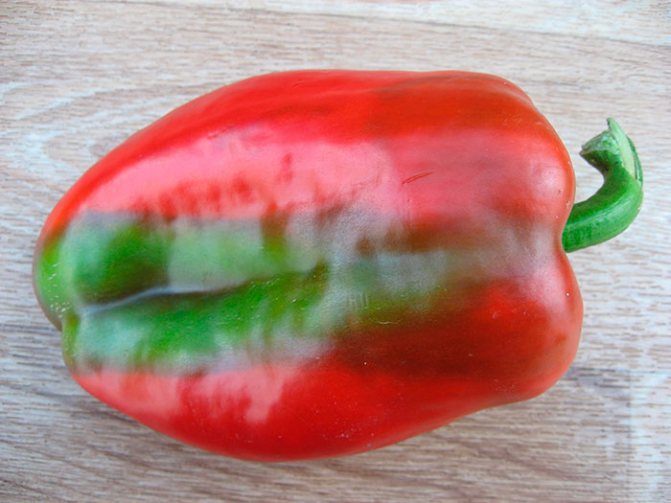
Growing vegetables that are environmentally friendly and healthy on their site is the dream of every plant breeder, and they achieve this with their hard work, tirelessly, sparing no effort or time for it. We have posted reviews of some of them here, you can also leave your comments and tell our readers about your experience.
- Oksana (36 years old, Kiev) - “I have been planting the Giant variety for the third year, I am always happy with the harvest. It is only necessary to change the place after 2-3 years. This is the main rule for pepper. "
- Vladimir (44 years old, Kostroma) - “I plant peppers in rows in a greenhouse, one row is a red giant, the other is a yellow giant. I like the red pepper, very fruitful. "
Eating home-grown vegetables is doubly enjoyable: you will be sure that they will only benefit you. Fresh in salads, canned or in any other form, they will delight you with their exquisite taste.
Pests and diseases
The main diseases affecting peppers - late blight, stolbur, rot, black leg, fusarium and others can not only reduce, but also completely destroy the crop of peppers.
Despite the fact that Giant pepper is resistant to many diseases, it is important to observe the following agricultural rules:
- Disinfect seeds before planting.
- Observe the rules of crop rotation - it is advisable to return the peppers to their original place or to the beds on which other nightshade crops were cultivated after 3-4 years.
- Avoid pests as they can spread infections.
- When using the greenhouse, treat it after the end of the season against fungal diseases
- During watering, weeding and feeding - healthy plants are less susceptible to diseases.
- When diseased plants appear (yellowing of the leaves, the appearance of weeping spots on them, as well as a slowdown in the growth of bushes will tell about the disease), they must be removed, preventive treatment of the remaining plants with Bordeaux liquid or phytosporin should be carried out.
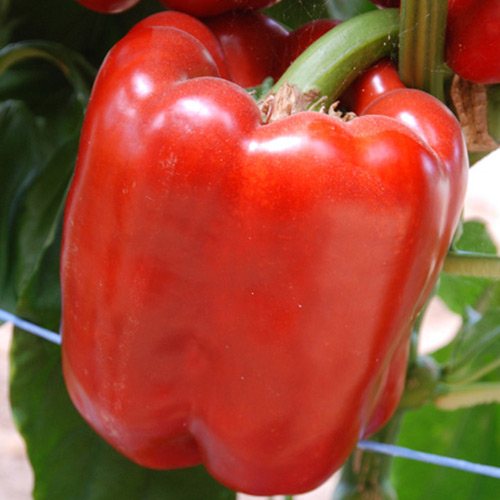

Reviews of summer residents about the hybrid
- Svetlana Abramova, 33 years old:
Before that, I planted the Red Giant variety. In the spring I saw Giant red pepper seeds in a dacha shop. I thought it was a typo on the pack. It turned out to be an earlier hybrid. I checked it personally! Indeed, the peppers ripened much earlier. But the excellent quality of the pepper remains the same. They are delicious, sweet, aromatic. The pulp is juicy and crispy. And of course how weighty they are! The husband jokes that you can kill them like that))) We fry them, pickle them, roll them up, and even so we eat them fresh. And in salads it is simply irreplaceable. - Galina Terekhova, 45 years old:
The giants do not let me down from year to year. Tore off a couple of peppercorns - that's enough for borscht, and for a salad to eat. I love them very much. The peppers are beautiful, shiny, delicious. Very large. And the yield is excellent. By the way, they also get sick very rarely. Recomend for everybody! I forgot to add - I grow pepper in a small greenhouse at my dacha.
Victoria pepper - description and characteristics of the variety
Advantages and disadvantages
The variety is attractive not only by the weight of the fruits, but also by the very appearance of powerful bushes, which, according to summer residents, represent a bright colorful spectacle, being hung with bright peppers.
In addition, the variety is valued for the following qualities:
- Excellent taste of peppers.
- High productivity.
- Disease resistance.
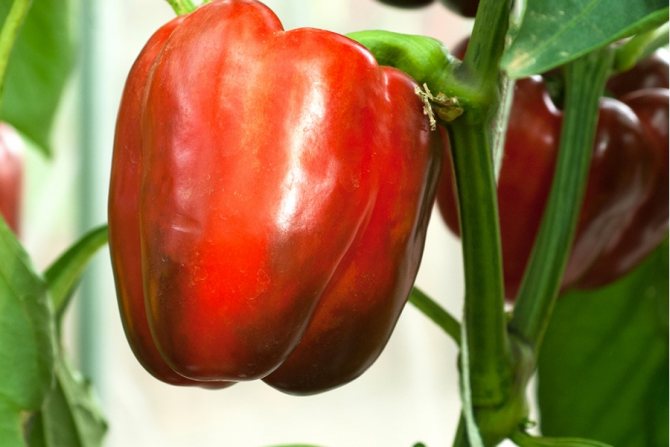

The disadvantages of vegetable growers include the fragility of the stems, which, even when tied to supports, easily break.
When to sow seeds for seedlings
The period from sowing to ready-to-transplant Giant's seedlings is at least 2 months, so the sowing time depends on where you plan to grow Giant red, in open beds or in a greenhouse:
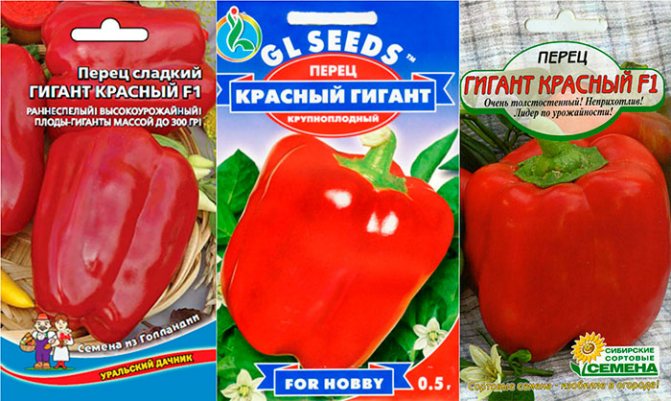

Pepper seeds
- January - early February, suitable for greenhouses, that is, the transplant is scheduled for April-May;
- the beginning of March is the optimal time for open ground, you can replant in June, when the weather conditions are most favorable.
Advice. We recommend purchasing Giant seeds (red, and not only) from trusted suppliers or from nurseries with a good reputation. Much depends on the quality of the seed: the compliance of the proposed variety with the basic requirements, yield, ripening time.
Features of agricultural technology
To get an early harvest of peppers, it is important not to miss the time of sowing the plant for seedlings. The optimum age of plants for planting in the ground is 60-65 days. Taking into account this period, gardeners determine the sowing time for their area, taking into account the fact that seedlings are planted in greenhouses 2-3 weeks earlier than in the ground.
It may be interesting The best varieties of cucumbers for the Rostov region The grapes "Codryanka" - early and tasty Pepper "Buratino F1": unpretentious with a high content of vitamins
The soil for growing seedlings should be nutritious, loose, and breathable. Usually it is prepared by mixing suburban soil with humus, ash, mineral fertilizers.
Growing seedlings
Before sowing, seeds are treated in disinfecting solutions and solutions of microelements or ash infusion. You can use a natural disinfectant - garlic juice, and as growth stimulants - aloe juice, honey.
Before sowing in the ground, seeds can be germinated - soaked in a damp cloth and placed for several days (before pecking) in a warm place at a temperature of 25-27 degrees.
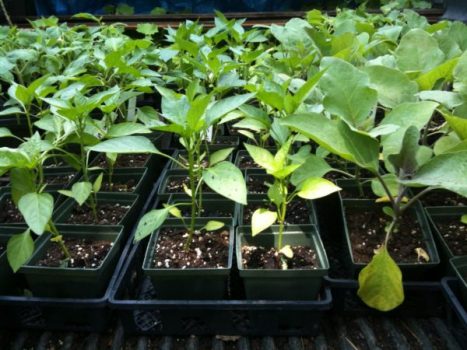

After the emergence of sprouts, the seeds are sown to a depth of about 1 cm with an interval of 2-3 cm, tightly closed, and kept at a temperature of 23-24 degrees until the emergence of shoots.
Secrets of Successful Growing
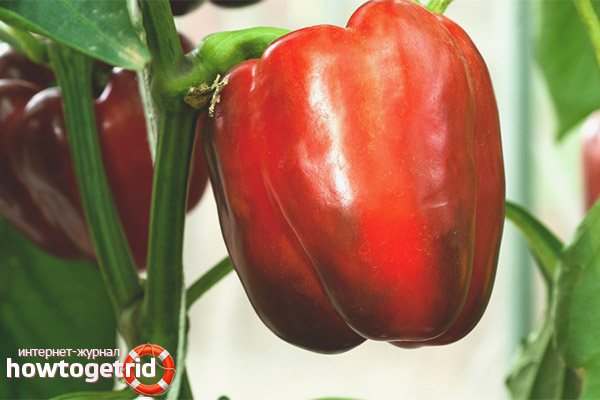

- Landing in places well lit by the sun. It is recommended to plant peppers according to the scheme: 75x45, where 45 cm is the distance between plants in a row, and 75 cm is the width of the row spacing.
- Compliance with crop rotation. Should not be planted after related nightshade crops (tomato, eggplant, potato). The best precursors are: onions, garlic, cucumbers, cabbage or radishes.
- Forming a bush of pepper into two stems.
- Improvement and enrichment of the soil by incorporating siderates (green fertilizers) into the soil. It is advisable to carry out agricultural reception, starting in autumn or early spring.
- Sow seeds for seedlings in late February or early March, depending on the growing region.
- Planting seedlings in open ground at the age of 50-60 days. Before planting in the soil, preliminary hardening is necessary, as well as treatment with complex fertilizer and a growth stimulator.
- Outdoor cultivation is only possible in the southern regions. In other areas, the cultivation of this hybrid is desirable only in greenhouses.
- Obligatory regular pinching, otherwise the size of the fruit will be smaller. As well as preventive examinations and sanitary cleaning of plantings.
- Seedling picking is carried out in the phase of 2 cotyledonous leaves.
- Regular and abundant watering is required. They need to be carried out in the morning or evening. Giant red F1 is especially demanding for abundant watering at the time of fruit filling.
- To maintain high yields, regular fertilizing with complex fertilizers, as well as growth stimulants, is required.
- Regular loosening and weeding of rows. Mulching plantings will save energy for gardeners, as well as protect the root system from overheating in the hot months.
pepper Gladiator - description and characteristics of the variety
Yellow Giant
Pepper variety Yellow Giant
An excellent representative of the Gigant variety, it is a great addition not only to any salad, but also when preserving cucumbers.
The yellow giant is an early maturing variety that is ideal for growing in warm areas. Each fruit is fleshy, the walls are thick.
Unlike the red giant, yellow does not contain beta carotene, but there is much more vitamin C and pectin, there is an interchangeability.
This pepper is ideal for those who are allergic to beta carotene or all red vegetables.
The yellow giant loves the direct rays of the sun, so it is more profitable to plant it in sunny places to darken other plants.
Red giant
Pepper variety Red Giant
This variety can be safely called the king of sweet pepper. It is useful, it contains much more beta carotene than carrots. In addition, there is a large supply of pectin.
The variety is mid-ripening, but for those who like bell peppers it is not a long time to wait two weeks longer than early ripening varieties. The bush is large enough with proper care and watering, and reaches a meter in height.
The fruits themselves are large-fruited, cube-shaped. The middle is quite fleshy and very tasty. Ideal for canning, as it contains a large amount of vitamin C.
The pepper, although large, is also good for stuffing. It is irreplaceable in any salads. It is also added to Ukrainian ratatouille along with orange and yellow peppers.
The fruits on it can be distinguished by their shape, but the benefits of pepper are still the same. If the pepper accidentally falls off or breaks off, do not get upset, you can put it in the shade, and it will turn red after two or three days.
You can read about fruitful varieties of pepper here.
Orange Giant
Pepper variety Orange Giant
Mid-season pepper variety. The bushes are quite massive, the fruits are cone-shaped.The pepper is fleshy, aromatic and juicy. Perfect for salads and stuffing.
The Giant orange pepper variety was specially bred for those who are allergic to red vegetables or fruits. Pepper is rich in potassium, vitamin C and pectin, which have a beneficial effect on the functioning of the whole body.
In order for the Orange Giant pepper bushes to grow large and strong, they must be planted at a distance of about a meter from each other and in a checkerboard pattern. The fifth and sixth flower on the bush is best broken off so that there are more ovaries.
Flamenco F1
The homeland of the Flamenco F1 hybrid is America, but it gives a high yield in the cold regions of our country.
According to the characteristics, the Flamenco hybrid belongs to early maturing peppers and is high-yielding. Farmers involved in the cultivation of this vegetable crop note that it has large fruits with excellent taste. Ripe fruits have thick walls (about 9 mm). On a medium-sized bush, fruits weighing 200 g grow. They are rather compact and not elongated downward, resembling a cube in shape. The width of the deep red fruit is almost the same along its entire length. From 1 sq. m collect 8-10 kg of fruits suitable for transportation.
Flamenco has a universal purpose. The plant has good keeping characteristics, therefore it is advisable to leave it for the preparation of fresh salads. In addition, Flamenco has a special peppery aroma that spices up fresh salads.
Plant care
Pepper is a thermophilic and demanding plant for watering.
How to water the pepper properly?
- Water the peppers several times a week. If the weather is very hot and dry, it is best to water daily.
- Watering peppers is best done in the morning, not in the evening, so the water will be absorbed throughout the day, and the risk of mold and rot will be minimized.
- It is necessary to pour water on the ground near the stem. Do not pour over the leaves of peppers, especially if they grow in the open field, in order to prevent burns.
- To maintain optimal soil moisture, it is recommended to cover the beds with hay or cut grass.
It is advisable to loosen the soil around the plants more often, to remove weeds in time.
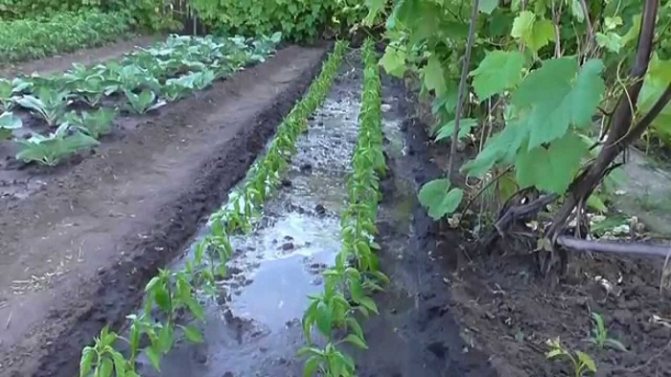

How to deal with pests?
It is important to constantly monitor that aphids and midges do not settle on the plants. To combat pests, use a soap solution (5 g of crushed laundry soap per liter of water, the solution is insisted for 5 hours and filtered), with which foliage and stems are wiped.
How to fertilize plants?
Plants respond well to potassium and phosphorus introduced into the soil, but they very poorly tolerate chlorine-containing fertilizers.
The rules for feeding plants are as follows:
- dressing for peppers grown outdoors is applied every two weeks, alternating organic fertilizers with mineral fertilizers. Greenhouse peppers are fertilized every 15-20 days;
- before fertilizing, the soil is watered abundantly with water;
- top dressing is diluted in warm, settled water;
- after applying top dressing, the soil is loosened.
Important! You cannot apply too much nitrogenous fertilizers, otherwise the plants begin to grow abundantly in green mass, and the yield decreases.
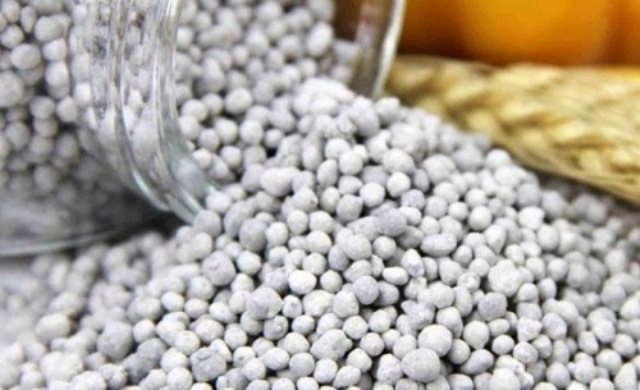

First feeding
during the flowering period. For a ten-liter bucket of water, take 5 g of superphosphate and 10 g of urea. The mixture is applied under the roots in the amount of one liter for each plant.
Second feeding
during the formation of ovaries. For fertilization, use an aqueous solution of mullein in a ratio of 1:10 or bird droppings in a ratio of 1:15 (leave for 5 days).
You can use herbal tea. Nettles and dandelions without roots and seeds are crushed and placed in a barrel. A bucket of mullein and a glass of ash are added there, filled with water to the top and covered with a lid. The “fragrant” mixture will be ready to use in a week. Pour 1-2 liters of liquid under each plant.
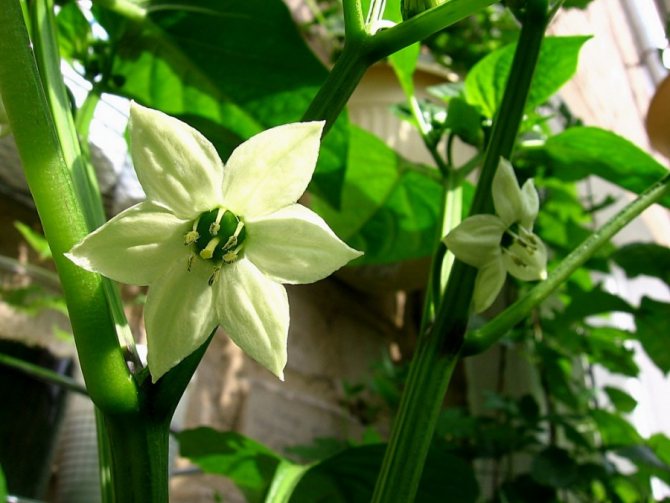

Third feeding
necessary during the ripening period of the fruit. In a ten-liter bucket of water, stir two teaspoons of superphosphate and potassium salt. Pour 1 liter of solution under each stem.
How to tie up peppers?
Peppers require a mandatory garter. For this purpose, we recommend to build mini-trellises from bars with a section of 40x40 mm and galvanized reinforcing construction mesh with cells of 50x50 mm.
The bars need to be cut into lengths of one and a half meters, and the mesh must be cut with metal scissors into pieces of 30x50 cm.The lower part of the bars must be hewn with an ax, sharpened so that it fits well into the ground.
You can attach the mesh to the bars with knitting wire or staples.
On a note! Treatment of wood with an antiseptic will extend the life of the mini-trellis.
The finished structures are driven in with a sledgehammer next to the root of the plant. As the pepper grows, it is tied to the net with soft ropes.
Late blight
Despite the fact that it mainly affects late-ripening crops, the likelihood of its appearance is high on peppers as well. The first symptoms are spots on the leaves, stems and, later, fruits. The spots are bright or pale brown.
Late blight spots lead to rapid drying of the bush. Fugnitsids ("Oxyhom", "Ridomil Gold", "Fitosporin" and "Ordan") and biological agents ("Alirin-B", "Gamair") are used as treatment.
Biological preparations: 1 tablet per 5 liters of water. Apply during watering. 2 tablets per 1 liter for spraying. 2 ways are alternated daily.
Fugnitsids: according to the instructions.
As a preventive measure:
- seeds are processed before planting,
- timely weeding and loosening of the earth is carried out,
- weak bushes are removed,
- compliance with the temperature regime,
- checkerboard landing pattern,
- moderate level of humidity,
- avoiding drafts.
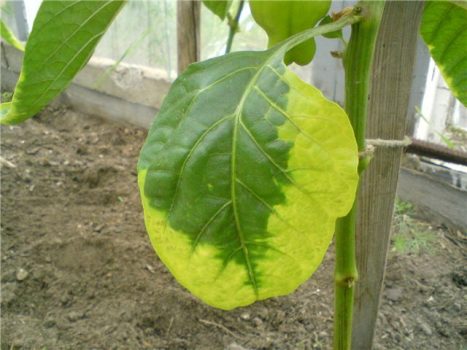

Sclerotiniasis (White Rot)
With such a disease, a white fungus appears on the stems, the fruits become soft and watery, a green bloom may be present.
Prevention methods:
- good cleaning of the site from any crop residues,
- strongly acidic soil is treated with lime,
- disinfection of the greenhouse before planting,
- adherence to warm and moderate watering,
- regular inspection (1-2 times every 10 days) for problems,
- as soon as you notice any fungus, treat the affected area with preparations containing a large amount of copper, and then with chalk or coal.
- removal of fallen areas.


